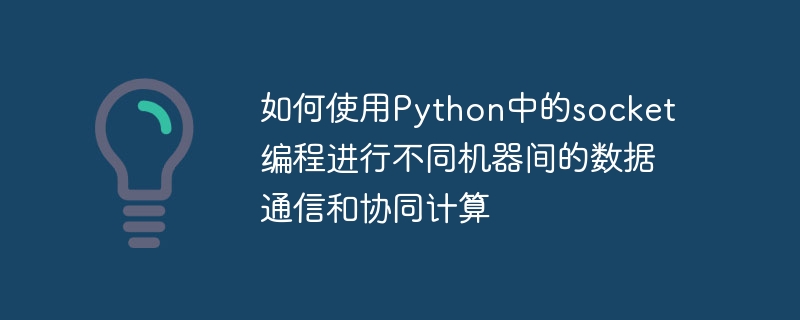

Title: Using socket programming in Python to realize data communication and collaborative computing between machines
Introduction:
In the computer field, data between different machines Communication and collaborative computing are one of the key technologies for realizing distributed systems and parallel computing. Socket programming in Python is a commonly used and powerful network programming tool, which can be used to realize data transmission and communication between machines. This article will introduce how to use socket programming in Python to achieve data communication and collaborative computing between different machines, and provide specific code examples.
1. Introduction to socket programming:
Socket programming refers to the method of using socket library functions for network communication programming. The socket library functions allow us to create, connect and send data to another program on the network. The socket module in Python provides the basic functions required for socket programming and can easily implement data transmission and communication.
2. Data communication example:
The following is a simple example that demonstrates how to use socket programming in Python to implement data communication between two machines.
Server code:
import socket
# 创建一个socket对象
socket_obj = socket.socket(socket.AF_INET, socket.SOCK_STREAM)
# 绑定IP地址和端口号
host = '127.0.0.1'
port = 8888
socket_obj.bind((host, port))
# 开始监听
socket_obj.listen(5)
while True:
# 建立客户端连接
client_socket, address = socket_obj.accept()
print('连接地址:', address)
# 接收客户端发来的数据
data = client_socket.recv(1024)
data = data.decode('utf-8')
print('接收到的数据:', data)
# 向客户端发送消息
message = 'Hello, Client!'
client_socket.send(message.encode('utf-8'))
# 关闭连接
client_socket.close()Client code:
import socket
# 创建一个socket对象
socket_obj = socket.socket(socket.AF_INET, socket.SOCK_STREAM)
# 定义服务端的IP地址和端口号
host = '127.0.0.1'
port = 8888
# 连接服务端
socket_obj.connect((host, port))
# 向服务端发送消息
message = 'Hello, Server!'
socket_obj.send(message.encode('utf-8'))
# 接收服务端返回的数据
data = socket_obj.recv(1024)
data = data.decode('utf-8')
print('接收到的数据:', data)
# 关闭连接
socket_obj.close()In the above code, the server will listen to the specified IP address and port number after running, and after receiving the client After the client is connected, the client's connection address will be printed out and the data sent by the client will be received. After receiving the data, the server will send a "Hello, Client!" message to the client. After the client connects to the server, it will send messages to the server and receive data returned by the server.
3. Example of collaborative computing:
Collaborative computing means that multiple machines jointly complete a certain computing task through the network, which can improve computing efficiency. The following is a simple example that demonstrates how to implement collaborative computing using socket programming in Python.
Server code:
import socket
import pickle
# 创建一个socket对象
socket_obj = socket.socket(socket.AF_INET, socket.SOCK_STREAM)
# 绑定IP地址和端口号
host = '127.0.0.1'
port = 8888
socket_obj.bind((host, port))
# 开始监听
socket_obj.listen(5)
while True:
# 建立客户端连接
client_socket, address = socket_obj.accept()
print('连接地址:', address)
# 接收客户端发来的数据
data = client_socket.recv(1024)
data = pickle.loads(data)
print('接收到的数据:', data)
# 对数据进行计算后返回结果
result = data * 2
# 向客户端发送计算结果
client_socket.send(pickle.dumps(result))
# 关闭连接
client_socket.close()Client code:
import socket
import pickle
# 创建一个socket对象
socket_obj = socket.socket(socket.AF_INET, socket.SOCK_STREAM)
# 定义服务端的IP地址和端口号
host = '127.0.0.1'
port = 8888
# 连接服务端
socket_obj.connect((host, port))
# 向服务端发送数据
data = 5
socket_obj.send(pickle.dumps(data))
# 接收服务端返回的计算结果
result = socket_obj.recv(1024)
result = pickle.loads(result)
print('计算结果:', result)
# 关闭连接
socket_obj.close()In the above code, the server will listen to the specified IP address and port number after running, and after receiving the client After the client is connected, the client's connection address will be printed out and the data sent by the client will be received. After the server receives the data, it will calculate the data and send the calculation results to the client. After connecting to the server, the client will send data to the server and receive the calculation results returned by the server.
Conclusion:
Using socket programming in Python can easily realize data communication and collaborative computing between different machines. Using socket programming, we can easily implement distributed systems, parallel computing and collaborative work. I hope the sample code in this article can help readers better understand and use socket programming technology in Python.
The above is the detailed content of How to use socket programming in Python for data communication and collaborative computing between different machines. For more information, please follow other related articles on the PHP Chinese website!




